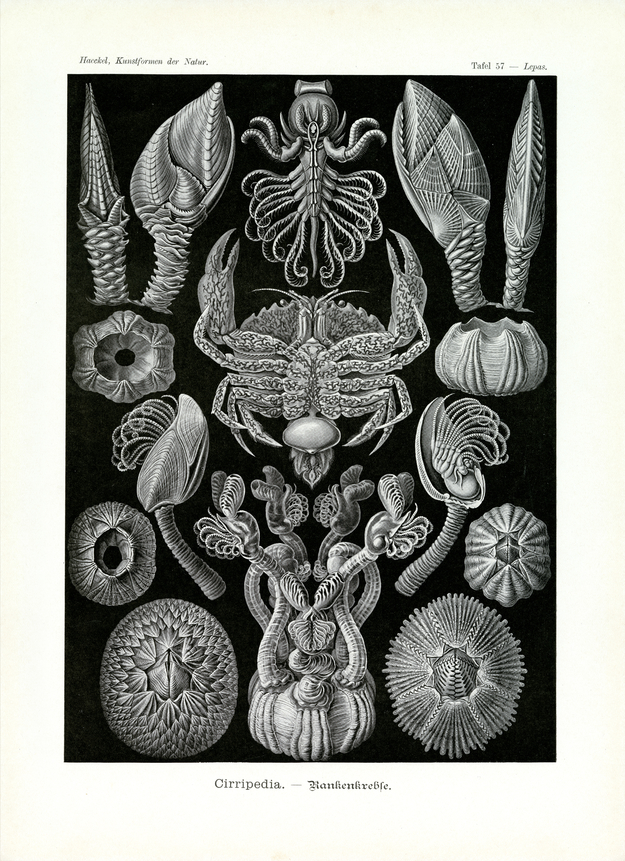Translation of the original German introduction by Ernst Haeckel:
The order of Cirripedia is distinguished from other orders of the most varied class of Cardonia by the fact that they have dropped completely the original free form of locomotion and adapted a fixed modus vivendi. The various levels of regression that are a consequence of this kind of adaptation can be exhaustively observed in Cirripedia. At first a large part of head regresses with brain, ‘sensing horns’ and eyes; for the most part only the mouth remains. The original separation of sexes (Gonochorism) changes over to hermaphroditism.
Furthermore, for the protection of the soft body a peculiarly shaped lime shell develops, segregated by a pair of broad “cover lopes” (thin skin folds of the dorsum). In Lepadinae (fig. 1-8) this shell is two-flapped and so similar to that of mussels (plate 55) that Lepadinae were initially considered a member of this class of Mollusca. Each of the two flaps (right and left) is composed of several lime plates; the shell is fixed on a strong, fleshy stalk that is at times covered with lime scales (fig. 5-8). – In Balanidae (fig. 9-14) the shell is without stalk, sitting with its broad base fixed on marine animals, rocks and other objects. The two ‘mantle-lopes’ are grown together into the shape of a tube which excretes a lime shell shaped correspondingly. It is frequently composed of radially organized lime plates, appearing in a most delicate form (six in fig. 9-12, eight in fig 14, numerous in fig. 13).
The living Mollusca, embedded in this shell, sits with its vestigial head fixed to the base of the shell, its abdomen protruding out of the shell opening. Usually the body carries (except for the small mouth parts) six pairs of long, multi-segmented ‘tendril-feet’ (fig. 1-4). They are densely covered with bristles and are moved by the fixed animals in a whirling way; thus food and fresh water for breathing are supplied to the body. In parasitic Cirripedia these feet wither completely just like the bigger part of internal organs. In parasitic Rhizocephalae or ‘root crabs’ the sexually mature animal forms an enormous pouch containing almost exclusively eggs and sperms; minute, branched ‘suction-tubes’ grow out of the mouth opening spreading in the body of the host onto which the parasite is fixed like a ‘fungal mesh’ (Mycelium)(compare the illustration of the crab in fig. 15).
Translation by VR Translators Bangalore
We've scanned the original lithography at 1200dpi on the Epson A3 scanner of A3 scanner huren. You can download a 400dpi JPEG here.
